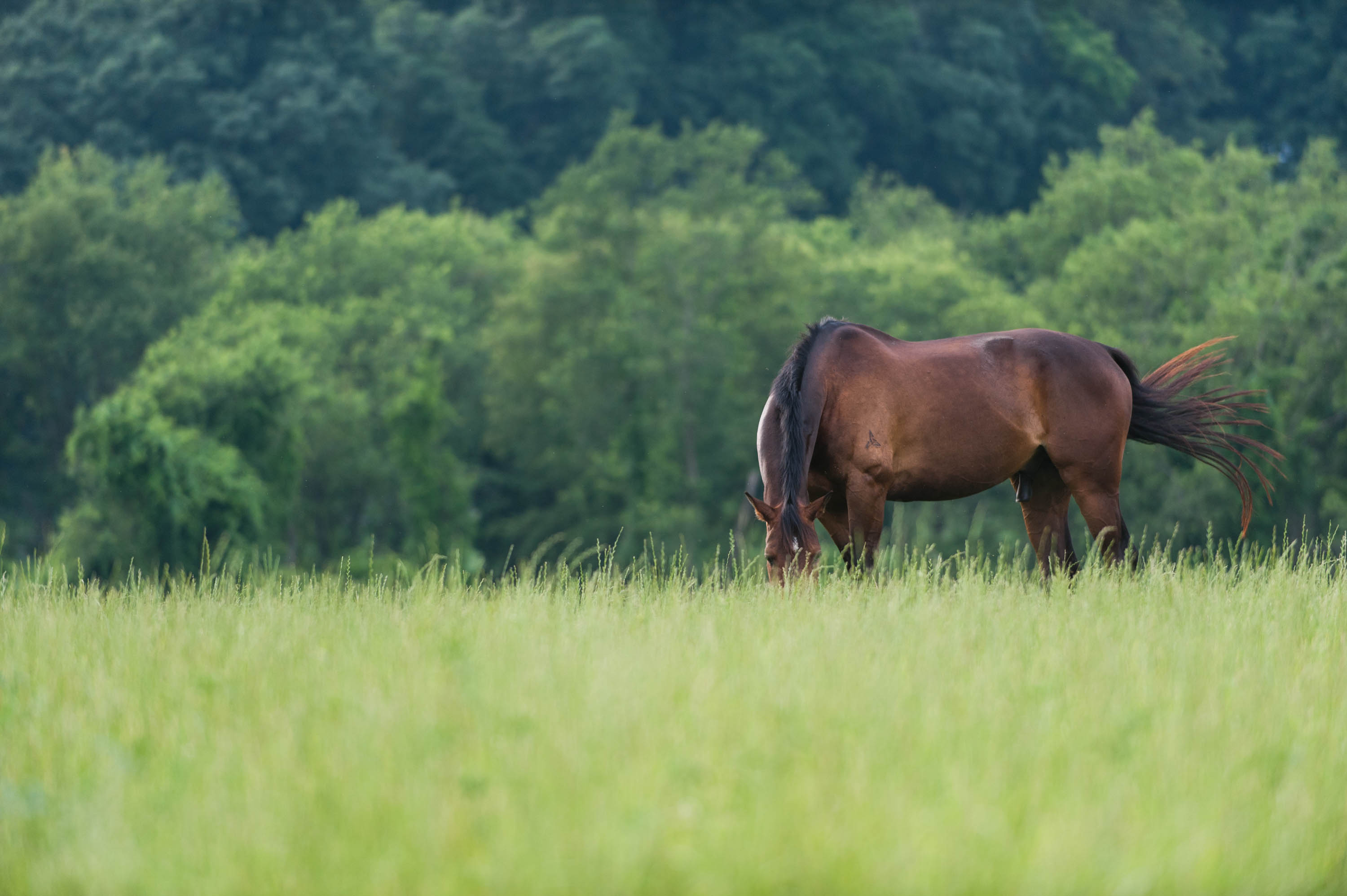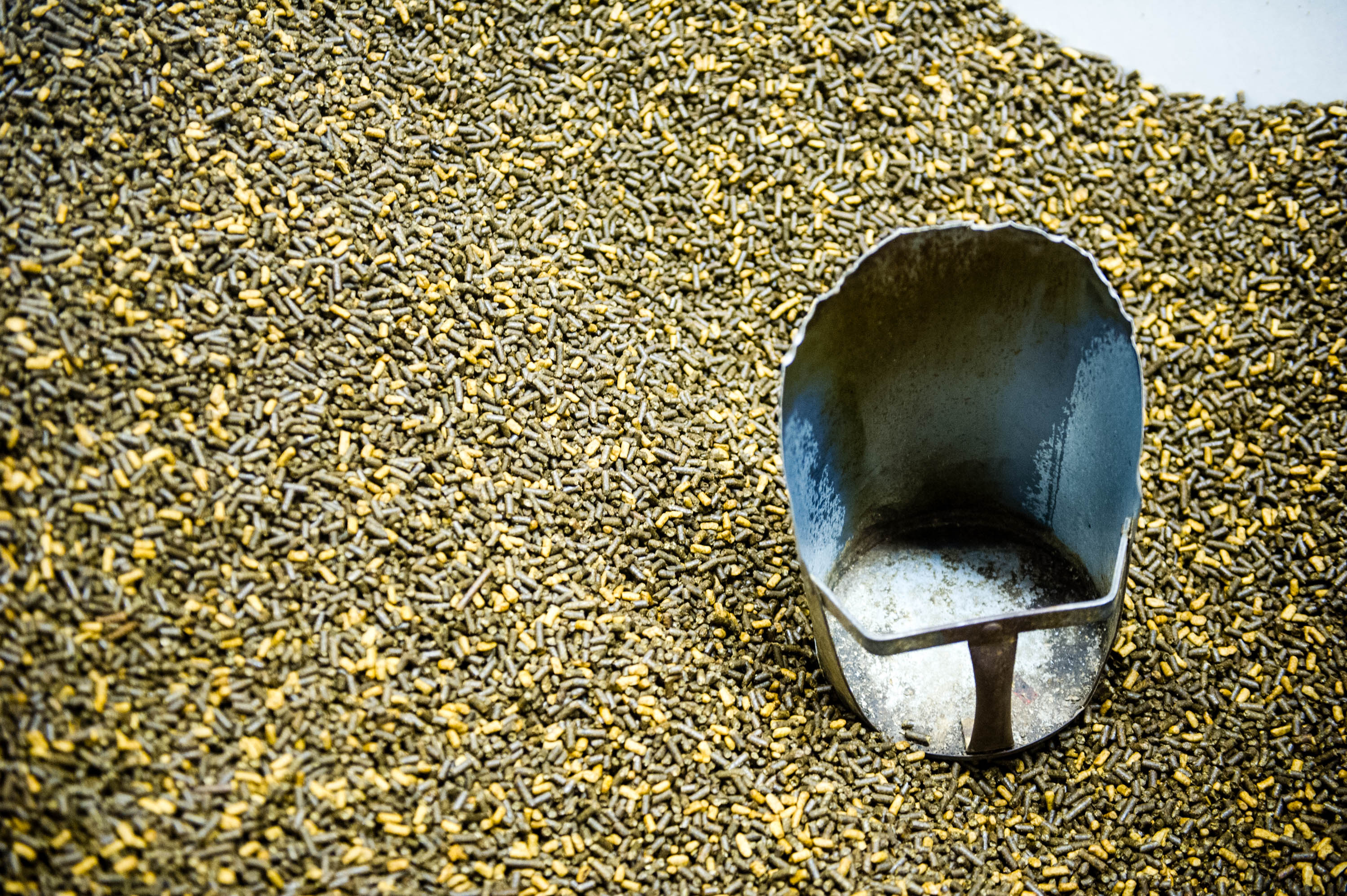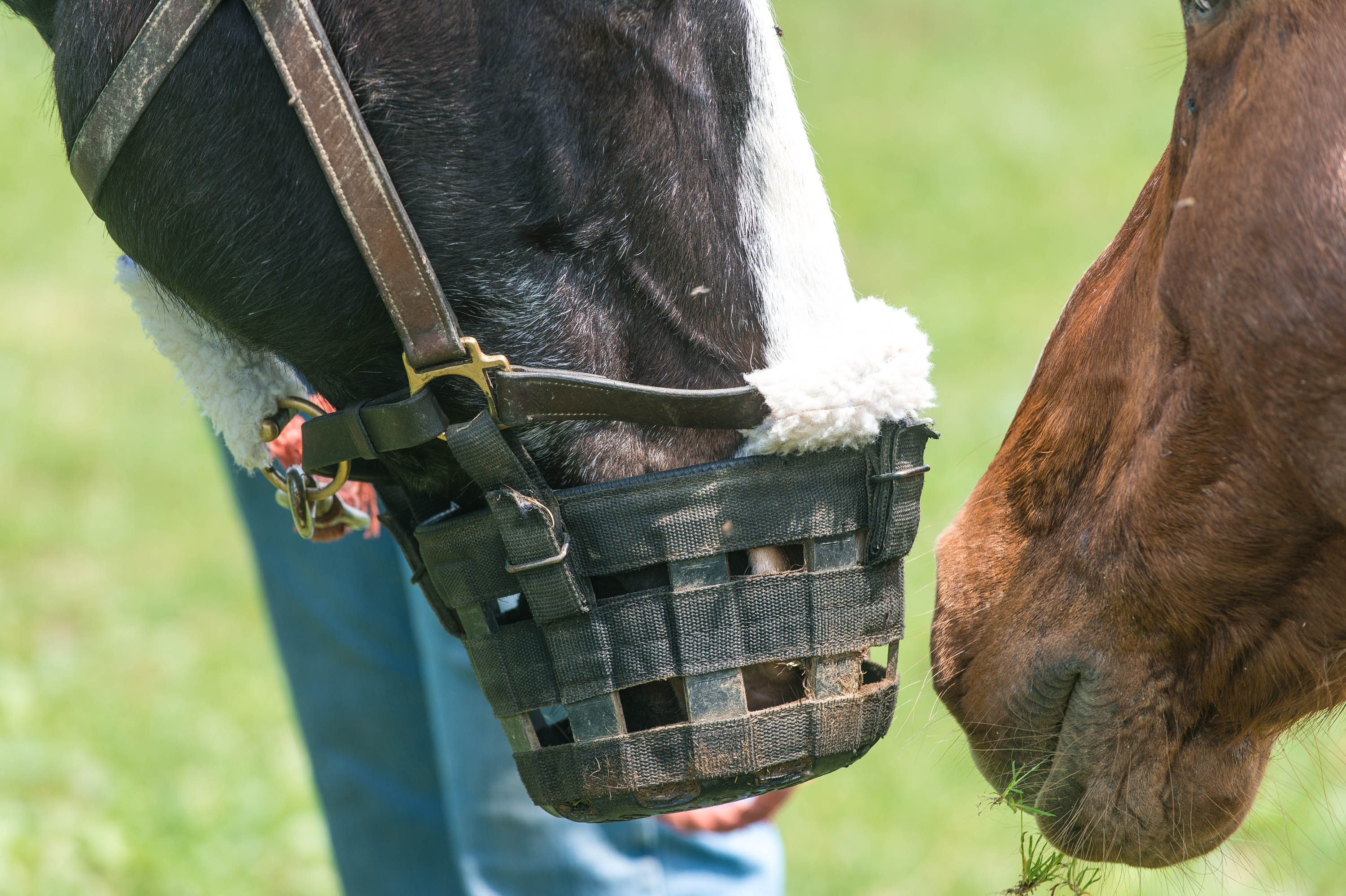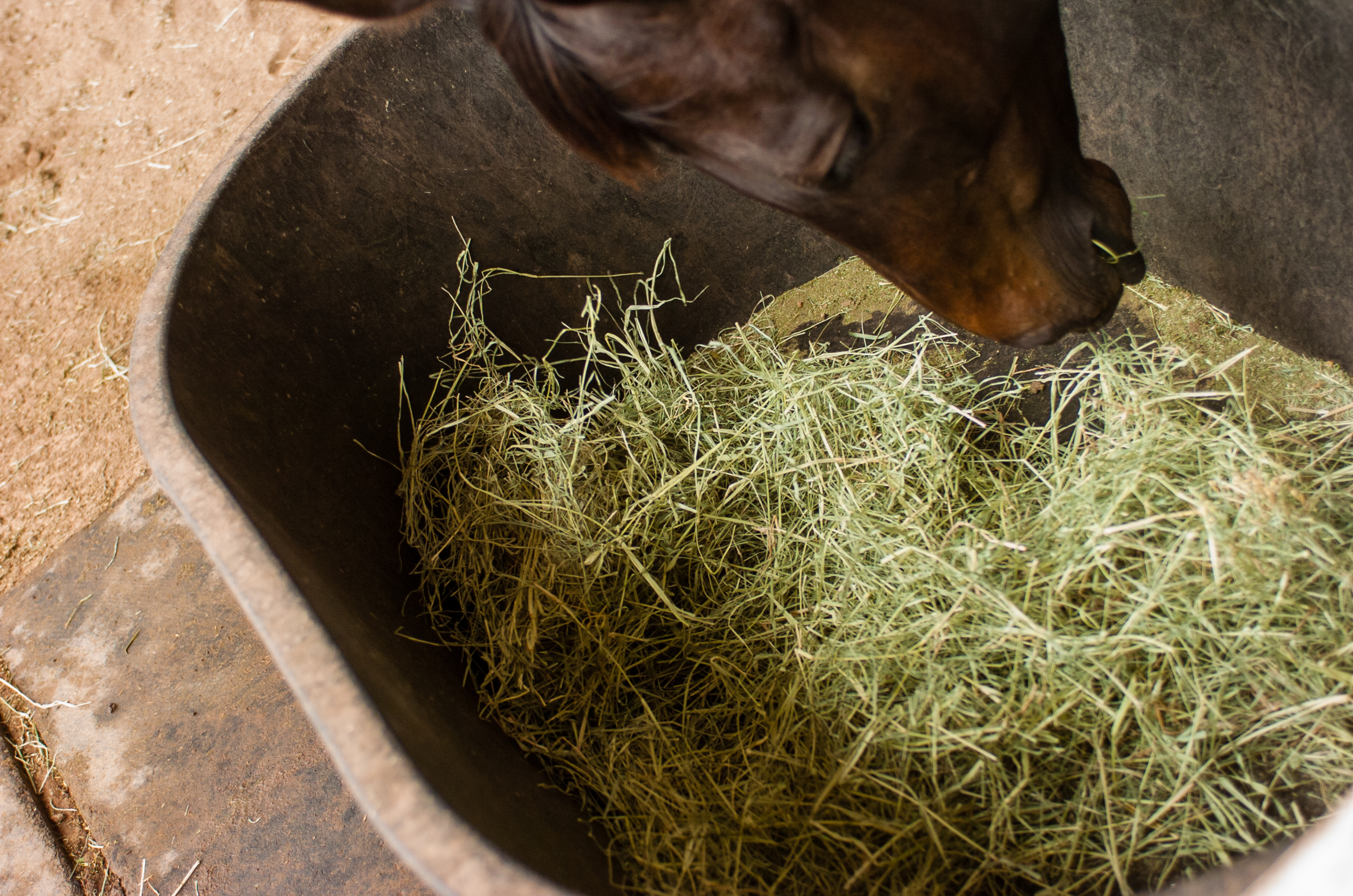The longer you’ve managed horses, the more likely you are to have encountered cases of insulin resistance, now frequently classified as “insulin dysregulation”—not to mention every horseman’s perennial worry, laminitis. Either condition is challenging enough on its own, but studies have confirmed that ID is a key risk factor for horses developing laminitis in a devastating progression of events.

Researchers have shown that it’s high insulin concentrations in the blood (hyperinsulinemia, or HI) that occur with ID that are the primary driver in the development of endocrinopathic laminitis (also called “hyperinsulinemia-associated laminitis,” or HAL). Exactly how HI causes HAL is still under investigation, but HAL is reportedly the most common form of this crippling condition. Indeed, it is said that endocrine (hormone) disorders have been identified in nearly 90% of horses presenting with laminitis. And laminitis can end a horse’s career—or even that horse’s life.
But here’s the thing: ID isn’t limited to pudgy ponies that are long in the tooth; even younger sporthorses can develop it. Fortunately, ID is often preventable and manageable, affording horse owners a chance to keep the more deadly HAL at bay.

Metabolic Matters
At the center of this pair of conditions is the hormone insulin, which is secreted by the pancreas and which plays a key role in your horse’s metabolism. Here’s the process:
- In a healthy, active equine, the starches and sugars in the grain and forage he consumes are converted to glucose during digestion.
- This glucose is then released into the bloodstream.
- This stimulates the release of insulin, which regulates the transfer of glucose into metabolically active tissues like those in skeletal muscle, adipose fat or the liver.
- Insulin also helps stimulate the synthesis of glycogen from excess glucose, promoting the storage of energy.
The more glucose is released into the blood, the more insulin is produced to facilitate either its immediate use or its storage.
So, what happens when the regulation of glucose transfer is disrupted or malfunctions? In this case, it’s all about buildup and overcompensation. “With insulin resistance, insulin doesn’t work properly—so glucose doesn’t go into the tissues properly,” explained Shannon Pratt Phillips, PhD, professor of Equine Nutrition & Physiology at North Carolina State University’s Department of Animal Science. “This causes the glucose concentrations to stay high, causing the pancreas to try to put out even more insulin to accommodate the glucose.
“Normally, glucose concentrations stay in a set range [approximately ~5 mM], but with a meal, particularly one higher in starch and sugar [like a grain meal, or a large amount of rich sugar grass], glucose concentrations will increase,” Dr. Phillips explained. “With insulin resistance, we start to see higher insulin concentrations even at ‘rest’ [HI], and then an exaggerated increase following a high-sugar meal.”
The link between HI and HAL is of particular interest to Amanda Adams, PhD, who is researching it at the University of Kentucky’s Gluck Equine Research Center.

“Several studies have used experimental models to confirm the central role of hyperinsulinemia in laminitis development and by correlating the severity of clinical laminitis with insulin concentrations in spontaneous, naturally occurring cases with endocrine disease,” Dr. Adams explained.
Once HI sets in, a relentless cycle is almost certain to follow. “This hyperinsulinemia over time decreases the sensitivity of tissues to insulin and leads to lower tissue glucose uptake,” Dr. Adams explained. “This tissue insulin resistance causes an increase in insulin secretion by the pancreas, especially after a meal, and thus further perpetuates the cycle.”
The cycle is particularly difficult to break when feeding occurs on an almost continuous basis. “This should be happening because horses are naturally grazers, but when these ID horses are already HI, one must be careful about feeding practices that could exacerbate the ID in these animals, which then sets them up for developing laminitis,” Dr. Adams said. “It can be a problem with both horses kept on pastures as well as being stalled; thus, it’s critical to be cautious of dietary practices and considerations, keeping in mind amount of hay being fed, quality and type of hay being fed, limited pasture access, careful not to offer grains, but consider offering safe balancer pellets to ensure all nutrients are being met.
The takeaway: “[While] the exact mechanisms by which abnormally high levels of insulin damage the laminar tissue are not fully understood, it is clear that control of hyperinsulinemia can help prevent laminitis.”
Risk Factors for ID
So, if controlling ID—and through that, hyperinsulinemia (HI)—can help prevent a common type of laminitis, how can we identify at-risk horses?
While symptoms of this condition are not readily apparent, Dr. Phillips noted that overweight horses, such as hunter types that are kept “fleshy,” are likely candidates for insulin issues (think cresty individuals or those with excess fat on their tailheads).

Age and breed/genetics can be factors, as well. “While horses of any breed are susceptible to developing ID, middle-aged horses are more likely to be affected as well as ponies, donkeys and horse breeds that are considered easy keepers … such as Morgans, Andalusians, Arabians, Paso Finos, Miniatures and warmbloods,” Dr. Adams said. “So yes, sporthorses can be susceptible. And those horses that are diagnosed with PPID may also be ID. And again, obesity is not always a component of horses being ID; i.e., it’s not just a fat horse problem.”
Philip Johnson, BVSc, MRCVS, professor of equine internal medicine at the College of Veterinary Medicine at the University of Missouri, added that in Miniature Horses and Shetland ponies, insulin resistance can also lead to “lipid mobilization and serious liver disease [hepatic lipidosis].” He went on to say that stress, corticosteroid use and inflammatory/neoplastic diseases are additional risk factors for insulin resistance.
If you suspect your horse has or is developing this condition, diagnosis begins with a basal [resting] fasting insulin measurement. “It can be checked fairly easily by a morning blood sample that is taken when a horse hasn’t eaten anything (fasted, or just having had hay overnight), Dr. Phillips said. “Typically, if a horse has insulin concentration higher than 20 uU/ml, [it] would be considered IR—though there would be varying severities. A horse with resting insulin concentrations of greater than 100 uU/ml would be worse off than a horse with 20 uU/ml.”
An additional step using the oral sugar test is recommended “to measure postprandial insulin levels following a Karo® syrup challenge,” Dr. Adams said. “We are also starting to recommend assessing insulin post a meal challenge to reflect insulin changes in the normal dietary management of the horse,” she added.
The ID-to-HAL Cliff
If all of this seems a bit bewildering, Dr. Phillips suggested visualizing it this way: “I imagine these risk factors as items on a cliff—obesity, IR, previous laminitis, breed/age, Cushing’s, etc.—and they just get horses closer and closer to the edge of the cliff. Then there appears to be some kind of critical event that pushes a horse into laminitis. The more risk factors a horse has, the closer to the cliff they are already.”
What exactly becomes the tipping point might depend on the individual and is still a matter of conjecture. “We don’t really know, but perhaps [the] high concentrations of insulin—or even glucose [can]—cause damage at the vasculature in the hoof,” Dr. Phillips offered. “The excess adipose [body fat] tissue in overweight horses can also produce pro-inflammatory compounds that might also cause some damage—again, kind of contributing to the ‘cliff,’ where the hoof might be at a critical point to begin with—and then a rush of insulin or something is what causes the ultimate damage/breakdown.” When all is said and done, though, HI remains the chief suspect in this mystery. “We now understand the importance of insulin dysregulation in these cases, and hyperinsulinemia appears to be the key event that drives the development [and recurrence] of laminitis: High blood insulin concentrations can directly damage the lamellae,” Dr. Adams said.
And in case you need a reminder about why laminitis should be avoided, here’s how Dr. Phillips described it: “Laminitis is the inflammation of the laminae, the vascular structures in the horse’s hoof that essentially work like Velcro® to hold the coffin bone to the hoof wall. When they get inflamed, they are painful (like ripping off a fingernail); and if the ‘Velcro®’ is really damaged, the hoof wall and the coffin bone can separate, and the coffin bone can start to rotate and ‘sink’ [founder].” The result is often chronic lameness, sometimes to the degree that warrants euthanasia.
Dr. Adams went one step further, adding, “What we oftentimes do not realize is the fact that horses with ID can have mild laminitis events causing cumulative damage over time, leading to more severe laminitis. Thus, early detection of ID, prevention, and monitoring and treatment of ID are all critical,” she emphasized.

Prevention and Management
Fortunately, ID can be prevented in many cases and, where already present, controlled or managed. The trick, as Dr. Adams said, it to try and catch it early—before the cycle can get started.
First, give your horse’s weight and feed regimen an honest evaluation, keeping an eye on those sugars, watching for fat buildup on the body, monitoring hoof growth (visible changes in hoof growth are often present before laminitic pain occurs) and consulting your vet if possible. “Some risk factors for insulin resistance can be reversed [e.g., obesity] through dietary amendments,” noted Dr. Johnson.
“Dietary management to get horses to a healthy body condition is vital [i.e., not overweight],” Dr. Phillips concurred. That includes, she said, “… limiting pasture intake [aka horse buffet], limiting hay, soaking hay prior to feeding [to decrease the sugars present in hay as well as] avoiding/decreasing grain.” She also suggested working with an equine nutritionist to help “… select a ration balancer or other type of feeding plan to make sure nutrients are met but limiting sugars and potentially calories.”
Affording your horse adequate exercise is another important way to help prevent or manage ID. “Exercise can increase muscle mass and improve glucose metabolism, so that helps improve insulin metabolism,” Dr. Phillips said.
When developing your horse’s wellness plan, also take into consideration any other individual risk factors, such as breed, age, medical history, etc. Is he a notoriously easy keeper? Has he had previous bouts with laminitis or endocrine disorders? To keep an eye on insulin concentrations, Dr. Phillips suggested investing in regular bloodwork (four to six times per year—or more, for higher risk horses/ponies). However, keep in mind that “… it is a sliding scale with a bunch of risks,” she added.
As Dr. Adams summed it up, “Controlling HI and ID is the key to help prevent laminitis in these horses, so the goal is to lower insulin—both basal insulin and postprandial insulin. Diagnosis is key … then controlling and managing potential exacerbating factors for hyperinsulinemia, including obesity, diet, inadequate exercise and concurrent PPID.”
In cases where these management methods fail to adequately address HI, Dr. Adams said that use of Thyro-L (a thyroid supplement) and Metformin (a biguanide/anti-hyperglycemic drug licensed for humans with metabolic syndrome/type 2 diabetes mellitus) may help lower insulin, thereby reducing the risk of laminitis. As always when considering pharmaceutical intervention, seek guidance from your veterinarian.
There’s an old saying that “awareness of a problem is half the battle.” With a clear link between hyperinsulinemia and laminitis established, researchers are working to better understand this process, the factors involved and how to prevent it. Meanwhile, savvy horse owners now have enough knowledge to help head off this dangerous cycle.

Other Common Causes of Laminitis
As noted in this article, almost 90% of equine laminitis cases are believed to be endocrine in nature—that is, associated with insulin dysregulation (a term that generally includes hyperinsulinemia, equine metabolic syndrome and insulin resistance); Pituitary Pars Intermedia Dysfunction (once called equine Cushing’s disease or syndrome); or a combination of these abnormalities.
“Nowadays, we think of PPID and the ID cluster (HI, IR, EMS) as being separate phenomena, but that some horses/ponies can develop both,” said Philip Johnson, BVSc, MRCVS, professor of equine internal medicine at the College of Veterinary Medicine at the University of Missouri. “Although on its own, PPID probably doesn’t cause laminitis, having PPID and ID in the same animal makes laminitis a possibility.”
So, what are the causes in the remaining 10% of laminitis cases? These reportedly range from excessive weight bearing situations or concussion to corticosteroid use, sepsis (such as can occur with a retained placenta) and hindgut acidosis (think grain-bin break-ins).
This article originally appeared in the Winter 2021 issue of Practical Horseman.











